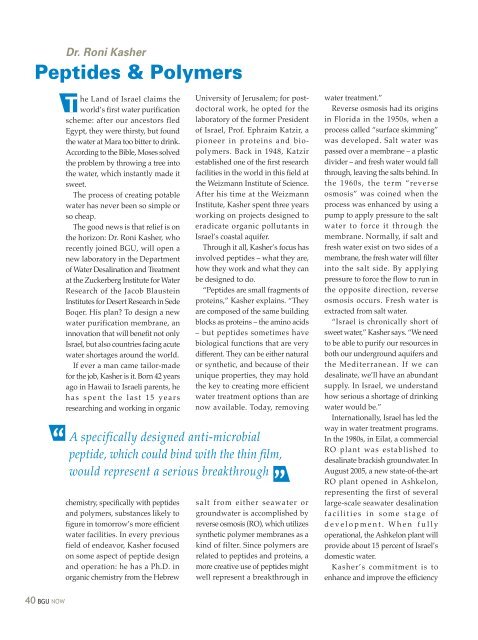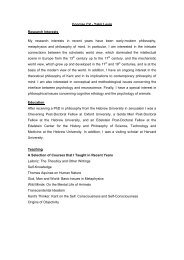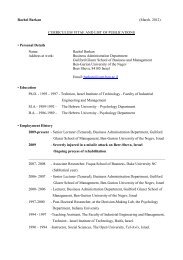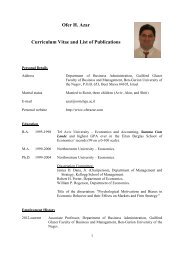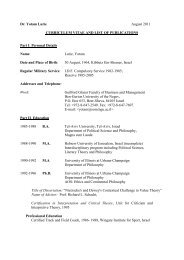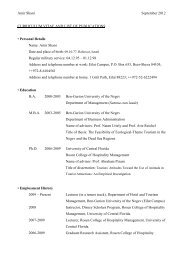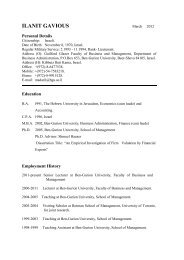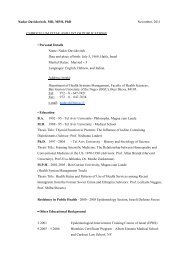cover 2006
cover 2006
cover 2006
Create successful ePaper yourself
Turn your PDF publications into a flip-book with our unique Google optimized e-Paper software.
Dr. Roni Kasher<br />
Peptides & Polymers<br />
40 BGU NOW<br />
T<br />
he Land of Israel claims the<br />
world’s first water purification<br />
scheme: after our ancestors fled<br />
Egypt, they were thirsty, but found<br />
the water at Mara too bitter to drink.<br />
According to the Bible, Moses solved<br />
the problem by throwing a tree into<br />
the water, which instantly made it<br />
sweet.<br />
The process of creating potable<br />
water has never been so simple or<br />
so cheap.<br />
The good news is that relief is on<br />
the horizon: Dr. Roni Kasher, who<br />
recently joined BGU, will open a<br />
new laboratory in the Department<br />
of Water Desalination and Treatment<br />
at the Zuckerberg Institute for Water<br />
Research of the Jacob Blaustein<br />
Institutes for Desert Research in Sede<br />
Boqer. His plan? To design a new<br />
water purification membrane, an<br />
innovation that will benefit not only<br />
Israel, but also countries facing acute<br />
water shortages around the world.<br />
If ever a man came tailor-made<br />
for the job, Kasher is it. Born 42 years<br />
ago in Hawaii to Israeli parents, he<br />
has spent the last 15 years<br />
researching and working in organic<br />
chemistry, specifically with peptides<br />
and polymers, substances likely to<br />
figure in tomorrow’s more efficient<br />
water facilities. In every previous<br />
field of endeavor, Kasher focused<br />
on some aspect of peptide design<br />
and operation: he has a Ph.D. in<br />
organic chemistry from the Hebrew<br />
University of Jerusalem; for postdoctoral<br />
work, he opted for the<br />
laboratory of the former President<br />
of Israel, Prof. Ephraim Katzir, a<br />
pioneer in proteins and biopolymers.<br />
Back in 1948, Katzir<br />
established one of the first research<br />
facilities in the world in this field at<br />
the Weizmann Institute of Science.<br />
After his time at the Weizmann<br />
Institute, Kasher spent three years<br />
working on projects designed to<br />
eradicate organic pollutants in<br />
Israel’s coastal aquifer.<br />
Through it all, Kasher’s focus has<br />
involved peptides – what they are,<br />
how they work and what they can<br />
be designed to do.<br />
“Peptides are small fragments of<br />
proteins,” Kasher explains. “They<br />
are composed of the same building<br />
blocks as proteins – the amino acids<br />
– but peptides sometimes have<br />
biological functions that are very<br />
different. They can be either natural<br />
or synthetic, and because of their<br />
unique properties, they may hold<br />
the key to creating more efficient<br />
water treatment options than are<br />
now available. Today, removing<br />
A specifically designed anti-microbial<br />
peptide, which could bind with the thin film,<br />
would represent a serious breakthrough<br />
salt from either seawater or<br />
groundwater is accomplished by<br />
reverse osmosis (RO), which utilizes<br />
synthetic polymer membranes as a<br />
kind of filter. Since polymers are<br />
related to peptides and proteins, a<br />
more creative use of peptides might<br />
well represent a breakthrough in<br />
water treatment.”<br />
Reverse osmosis had its origins<br />
in Florida in the 1950s, when a<br />
process called “surface skimming”<br />
was developed. Salt water was<br />
passed over a membrane – a plastic<br />
divider – and fresh water would fall<br />
through, leaving the salts behind. In<br />
the 1960s, the term “reverse<br />
osmosis” was coined when the<br />
process was enhanced by using a<br />
pump to apply pressure to the salt<br />
water to force it through the<br />
membrane.Normally, if salt and<br />
fresh water exist on two sides of a<br />
membrane, the fresh water will filter<br />
into the salt side. By applying<br />
pressure to force the flow to run in<br />
the opposite direction, reverse<br />
osmosis occurs. Fresh water is<br />
extracted from salt water.<br />
“Israel is chronically short of<br />
sweet water,” Kasher says. “We need<br />
to be able to purify our resources in<br />
both our underground aquifers and<br />
the Mediterranean. If we can<br />
desalinate, we’ll have an abundant<br />
supply. In Israel, we understand<br />
how serious a shortage of drinking<br />
water would be.”<br />
Internationally, Israel has led the<br />
way in water treatment programs.<br />
In the 1980s, in Eilat, a commercial<br />
RO plant was established to<br />
desalinate brackish groundwater. In<br />
August 2005, a new state-of-the-art<br />
RO plant opened in Ashkelon,<br />
representing the first of several<br />
large-scale seawater desalination<br />
facilities in some stage of<br />
development.When fully<br />
operational, the Ashkelon plant will<br />
provide about 15 percent of Israel’s<br />
domestic water.<br />
Kasher’s commitment is to<br />
enhance and improve the efficiency


